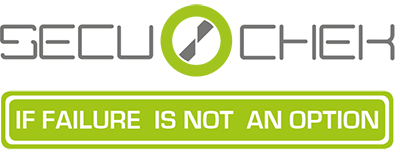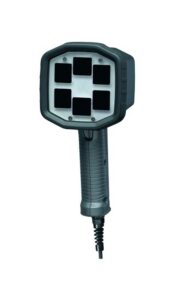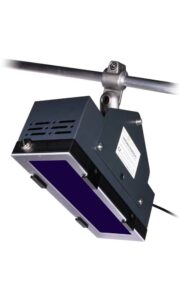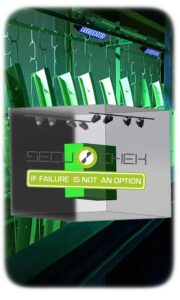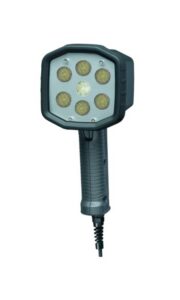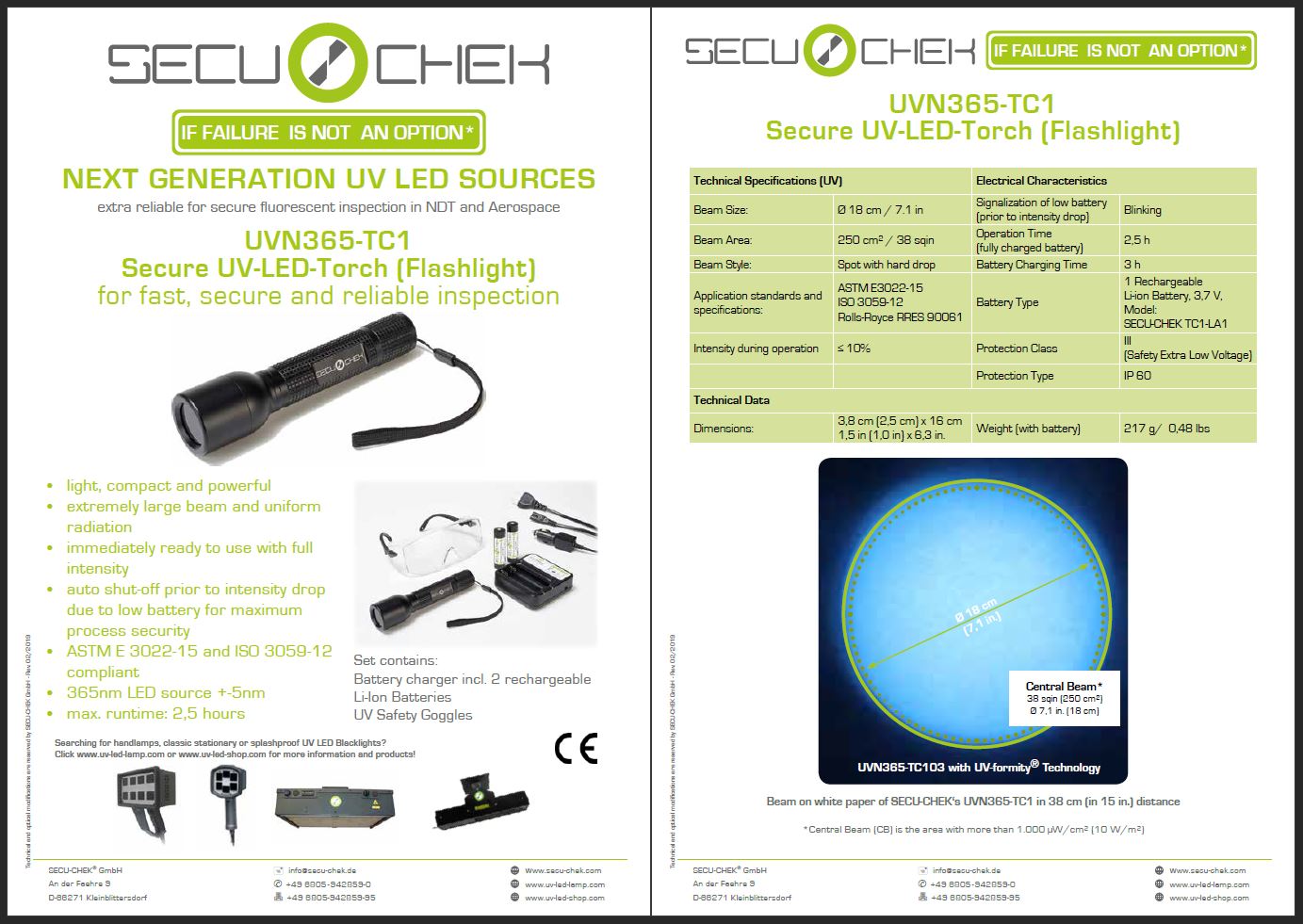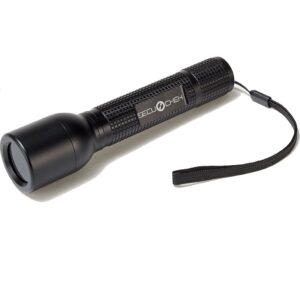TC1 UV-LED Flashlight Series
UV flashlight for non-destructive testing (NDT): for fast, secure and reliable inspection
The TC1 UV-LED flashlight for industrial professional applications compared to other UV black light flashlights (365nm)
UV flashlights and especially UV-LED flashlights have many uses in industry. A high level of quality and reliability is particularly important for UV-LED flashlights for NDT (non-destructive material testing) in order to guarantee absolutely reliable displays and test results with the UV flashlight.
- Professional UV flashlights: UV-LED flashlights for NDT and a large number of other industrial applications, some of which are relevant to safety
- Semi-professional or hobby UV flashlights for private use and the simplest black light / UV applications
With the TC1 series from SECU-CHEK, we would like to introduce you to one of the UV flashlights at the highest level for NDT applications and compare it with conventional UV LED flashlights. The technology-leading TC1 UV black light flashlight convinces the user in many respects and leaves nothing to be desired when it comes to daily practice under harsh, industrial working conditions.
Learn the features of the UV flashlights for crack testing, magnetic particle testing, leak detection and much more. know.
TC1 UV LED flashlight series
for fast, safe and reliable inspection at NDT
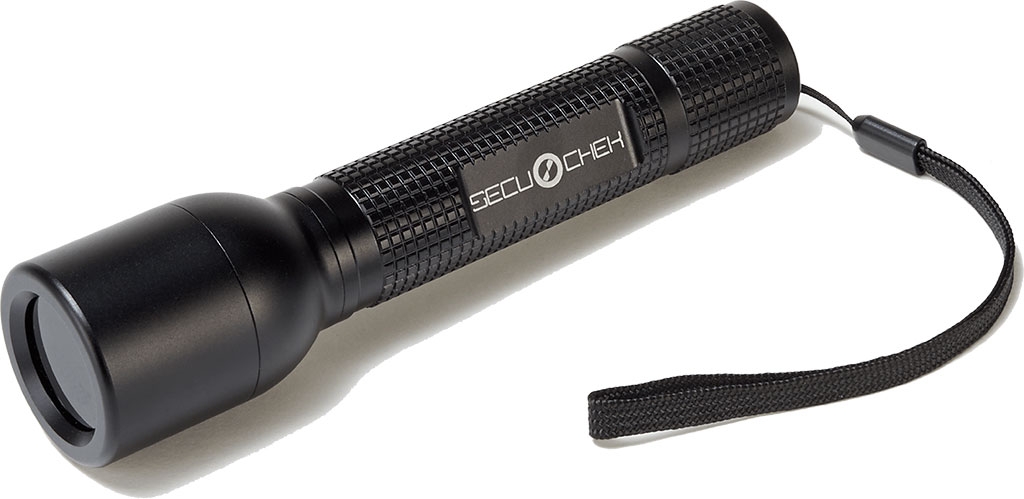
large, extremely even illumination without disturbing inhomogeneities
optimal for non-destructive testing (NDT)
optionally qualified according to all common standards (Airbus, ASTM, Rolls-Royce, ISO 3059,…)
long service life and very robust design (IP 65 protection)
optional accessories for easy and stress-free UV inspection, e.g. UV goggles, mobile charger, carrying case and much more.
Highlights of the TC1 UV-LED flashlight
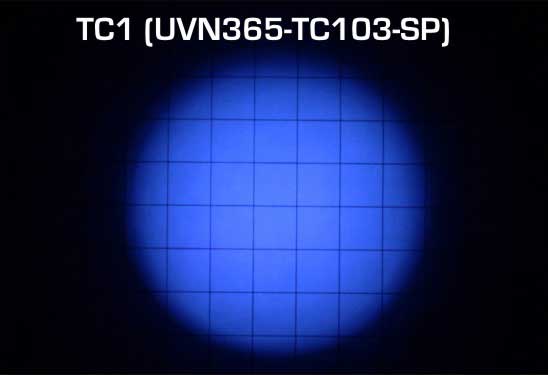
Very large, extremely homogeneous illumination area
-
Compared to conventional UV flashlights with Ø 18 cm / 7.1 in
-
extremely even illumination thanks to UV-Formity technology
-
no disturbing inhomogeneities, no artefacts
-
very clear, reliable displays and therefore reliable results
-
ideally suitable for NDT (non-destructive testing)
Immediately ready for use at full intensity
-
ready for use at the touch of a button without delay
-
UV flashlight with high quality UV LED technology (365nm LED +-5nm)
-
no waiting, work without delay
-
direct full intensity, electronically monitored
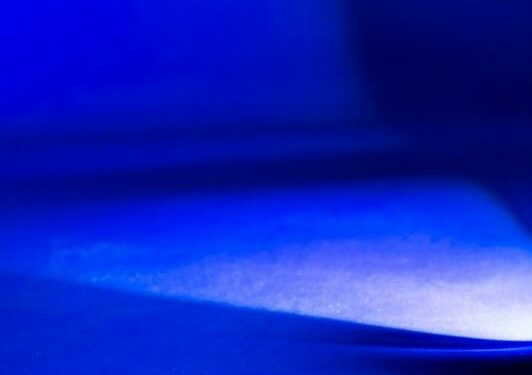
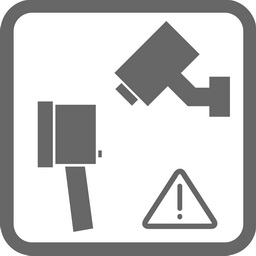
High reliability and process safety
-
compared to conventional UV flashlights
-
electronic monitoring
-
when the battery level is low, the UV torch starts flashing
-
prevents the intensity from decreasing when the battery is low
-
In this way, inspections are only reliably carried out with the right UV intensity
-
Auto-shutt-off of the UV LED flashlight when the intensity drops for maximum process reliability
Very user friendly & practical
-
light and compact (only 217g incl. battery!)
-
Powerful with 1,000 μW/cm² (10 W/m²)
-
simple one-hand operation with a push button at the end of the handle
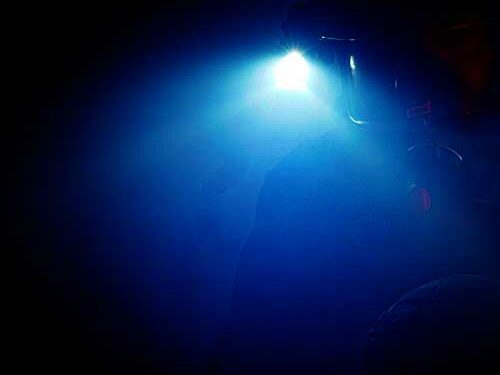

Optionally qualified for NDT standards etc.
-
Qualification according to all common standards, including:
-
AIRBUS
-
ASTM E3022
-
Rolls Royce RRES 90061
-
ISO 3059
-
and much more.
Long service life, very robust construction
-
strong IP65 protection against dust, water, rain and water jets
-
SELV 3 extra low voltage for safe operation (Safety Extra Low Voltage)
-
Robust, ergonomically shaped aluminum housing for use in harsh industrial environments
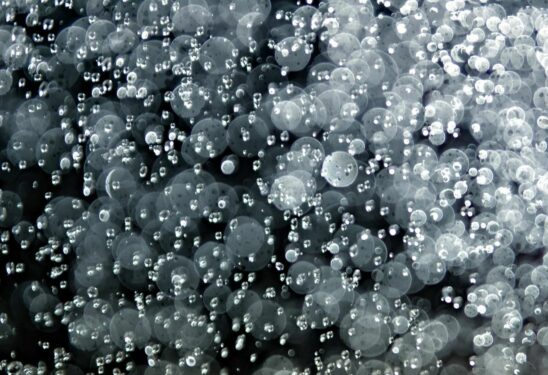

Up to 4 times larger illumination area*
-
* compared to conventional UV flashlights
-
Light cone (beam size) = very large working area with Ø 18 cm / 7.1 in at a distance of 38 cm (15 in.)!
-
Illumination area (beam area) = 250 cm² / 38 sqin !
-
very strong UV intensity with more than 1,000 μW/cm² (10 W/m²) and ≤ 4,800 μW/cm² (48W/m²) in the light cone!
-
extremely even illumination thanks to UV-Formity technology
-
no disturbing inhomogeneities, no artefacts
Long working time & fast charging
-
up to 2.5 hours of uninterrupted operating time
-
short charging cycle of 3h
-
rechargeable Li-ion battery, 3.7 V
-
Mobile charger and additional batteries for the UV flashlight available
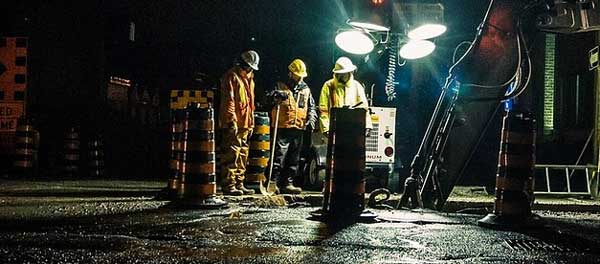
The right version of the TC1 UV-LED flashlight for every application
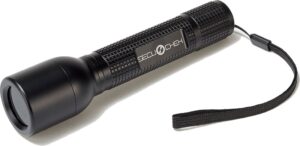
UVS368-TC103
-
Basic UV-LED flashlight TC1
-
Suitable for all common standard applications
-
ideal for leak detection/leakage detection, UV curing, geo-caching and much more.

UVN365-TC103-SPF
-
UV-LED flashlight TC1 for demanding applications
-
ideal for NDT (non-destructive testing)
-
without individual qualification

UVN365-TC103-SP
-
ZfP professional UV-LED flashlight TC1 with a qualified peak wavelength of 365 ±5 nm
-
Individual qualification according to aviation standards etc. according to your requirements
-
ideal for visual inspection (NDT), clean room inspection and much more.
Accessories & Extensions
-
UV goggles
-
replaceable Li-Ion battery
-
compact charger
-
optional handy carrying case for the TC1 set
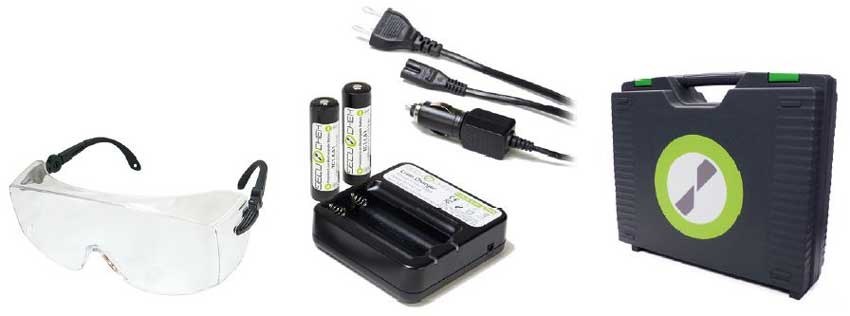
TC1: UV flashlight with high safety standards
-
UV flashlight flashes when the battery is low
-
Wear eye protection when using the TC1 UV LED flashlight
-
Warning:

UV flashlight for NDT and leak detection - The TC1 is the best UV LED flashlight for professional users in the test and comparison
As a UVA torch with innovative UV-LED technology for NDT (non-destructive testing) and leak detection and location, the TC1 black light lamp is characterized by a high UV intensity with a very uniform illumination. The strong UV lighting makes sense in the area of leak detection, here you can scan the areas quickly and reliably and find what you are looking for as soon as fluorescence becomes visible. There are various standards specifically for NDT that a UVA flashlight must also comply with. Here you are well equipped with the TC1 UV flashlight, which can be certified according to any international standard. However, this is only one of the other plus points for this UV lamp. This UVA flashlight is equipped with a very even UV illumination according to the UV-Formity technology. This is one of the main advantages, which is particularly noticeable in the rough everyday life in industry. Because this UV technology prevents the eyes from tiring too quickly. The gentle drop in radiation around the illumination area of the UV flashlight means that the eye does not have to get used to it so quickly, small cracks are easier to detect. This leads to more safety because you can work more reliably and quietly, but at the same time more quickly.
The modern design of the UV flashlight with a robust and durable housing is easy to hold, has a non-slip, ribbed handle and is therefore a good companion even in narrow, hard-to-reach areas. As a professional device, the TC1 UV flashlight is logically in a completely different price range than is usual in the hobby and semi-professional sector. Nevertheless, this UVA flashlight impresses with an excellent price/performance ratio.
Because with the TC1 UV flashlight you get a quality that is second to none and is developed by NDT experts with years of experience in theory and practice. As soon as you press the push switch of the 365nm UV flashlight, you will see what makes this UV flashlight special. This UV lamp need fear no comparison. So it is more than logical that this UV flashlight is primarily used in the aerospace sector when it comes to inspecting engines and other safety-relevant parts.
As soon as an error in the inspection of the machines and components can lead to major damage or even the loss of life, you will also become aware of how safe and reliable this UV flashlight can be with an extremely favorable price/performance ratio. The TC1 UV flashlight is in a league of its own.
If you would like to experience the TC1 UVA flashlight live and test it, please contact us!
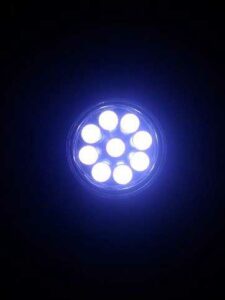
More categories of UV flashlights and special flashlights:
-
UV flashlight 365 nm</ h4>
-
Powerful flashlight
-
Blue-light torch</ a>
-
UV LED torch
-
the better one Alternative to the Spectroline Optilux UV flashlight
-
Flashlight forum for hobby and semi-professional UV lamps
What properties should a UV flashlight have so that it is particularly suitable for NDT (non-destructive testing) and leak detection (leak detection)?
-
it should be a UV flashlight with a wavelength of exactly 365 nm (max. +/- 5nm depending on the standard)
-
The UV flashlight should be very reliable and, above all, stable in performance, e.g. with built-in safety mechanisms like the TC1
-
The TC1 UV flashlight has integrated electronic monitoring and can be qualified according to all NDT standards

When you buy a UV flashlight, you should pay particular attention to the quality: You probably use the UV flashlight every day to detect cracks, leaks, etc., which are made safe by identifying them under UV light. If the flashlight does not meet the highest requirements here, you or your company will probably have significant additional costs elsewhere due to errors not being found.
What UV radiation is there and which type of UV radiation is used specifically for NDT in crack testing, magnetic particle testing, etc.?
There are different wavelengths. Humans can recognize wavelengths from 380 to 780nm as light. The cone of light with ultraviolet radiation can consist of three areas, in this area from 100 to 380nm, the electromagnetic radiation is invisible and is only visible indirectly through fluorescent dyes etc.:
UVA radiation in the wavelength range of 315-380nm: Long UV waves with lower energy
UVB radiation in the wavelength range of 280-315nm: short-wave and high-energy
UVC radiation in the wavelength range of 100-280nm: very short-wave and very high-energy
In the field of non-destructive material testing (NDT), UVA radiation is used in UV flashlights and UV-LED lighting systems. There are many possible applications for UVA flashlights and UVA lights in general:
- NDT: Fluorescent penetrant testing, magnetic particle testing,..
- Leak detection, leak detection and crack detection
- Checking the authenticity of banknotes
- Riboflavin test
- Visual inspection with tracers and markers
- Clean room inspection / wafer inspection
- UV curing / UV drying
- UVA test in the field of solar systems, solar cells, photovoltaics, sun simulation
- Gemology / gemstone research
- and much more.
Good UV safety glasses, for example safety glasses with EN 170 certification is mandatory when working with UV radiation, you should definitely observe these occupational safety regulations.

Questions and answers about UV flashlights for NDT
What types of UV lamps are there and what are the advantages of a UV flashlight?
As an NDT inspector, you also have to carry out non-destructive testing on industrial plants, chemical plants and other plants with hard-to-reach places. Piping that is hidden or located in small corners. With a large UV LED lamp or even mercury vapor lamp you have several problems or you may not be able to carry out the crack detection at all because:
- the UV-LED lamp is too big. A UVA flashlight like the TCI, on the other hand, is small, handy and you can be mobile anywhere.
- the UV lamp can only be used with a cable and power supply unit. The TCI UV flashlight is equipped with rechargeable batteries and can be used for several hours.
- the TCI UV-LED flashlight also fits well in a jacket pocket or on the belt. If you have to climb ladders to get to the testing station, you have your hands free and can then safely carry out the NDT test with the LED UV flashlight.
How many LEDs or what UV intensity should a UV flashlight for NDT have?
- Ultraviolet flashlights are available in different versions with one LED, but some are also equipped with up to 50 or more LEDs
- The UV intensity of an LED black light flashlight depends to a certain extent on the number of LEDs, but many other factors also play a role.
- for NDT (non-destructive material testing), the UV illumination range and the homogeneity of the illumination is a very important aspect. If, in addition to the UV intensity, the illumination area is large, there is a soft fall-off in radiation at the edge and the homogeneity of the ultraviolet flashlight is perfect, then you can work best and most safely and will be able to complete the best possible penetrant inspection or magnetic particle inspection efficiently and in accordance with all standards.
- for NDT it is important that the industrial UV flashlight is focused and illuminates homogeneously. The TC1 UV Flashlight is available in this configuration.
- for leak detection, leak detection (crack detection), in addition to the UV intensity, a large illumination area is very advantageous.
With the TC1 UV black light lamp, we offer all versions and versions that are optimal for the specific area of application. It is part of our professionalism and motivation as a UV flashlight manufacturer that we give you the best advice and that our development of the TCI is so flexible and standardized at the same time that we can customize the TC1 perfectly for you for all of the applications mentioned.
Buying a UV flashlight – what should I look out for when buying a UV flashlight with a wavelength of 365 nm, especially for NDT?
In advance – when buying a flashlight with UV LED technology, you should seek advice from experts – this is the only way you will ultimately receive the quality that is necessary for the work and the fulfillment of the specific NDT task. Here is a small checklist that you can use when buying a UV flashlight:
-
TC1: the professional UV torch with 365nm wavelength for NDT
what ultraviolet intensity do I need for NDT testing? Are there special requirements for the working distance, the illumination area, etc.?
- for which application has the UV flashlight been tested and developed? Is the UVA hand lamp from a professional manufacturer? Can standards and norms of the aerospace industry be implemented, i.e. can the UV high-performance LED flashlight be qualified accordingly?
- How often is the UVA flashlight used? Are there specific specifications regarding charging cycles and continuous operation?
- How high is the IP protection of the UV LED flashlight?
- Which accessories and which connections are possible with the UV flashlight? UV flashlight with battery operation/rechargeable battery, charger, power supply? Where in the company are the NDT tests with the black light flashlight primarily carried out?
- how stable is the performance of the UV flashlight? Are all specifications regarding the wavelength and the safety measures to ensure that it works reliably within the required standard range consistently observed? Can the UV flashlight manufacturer guarantee this?
- Can I test the UV flashlight live in advance? Is it possible to experience a live demo on site before I buy the UV flashlight for NDT? Can I see and use the UVA flashlight compared to other UV flashlights? >> this is possible with us, please contact us!!
What are the features and advantages of the TC1 UV flashlight over other UV LED flashlights?

The NDT flashlight TC1 with UV-LED is a flashlight that has never existed before in terms of performance and functionality. The TC1 UV Torch contains all the features an MPI and FPI inspector needs to perform a fast, safe and reliable inspection.
- The TC1 flashlight is more powerful than most standard flashlight-sized handheld UV lamps
- safe inspection by electronic UV-LED monitoring with safety shutdown
- full handheld lamp qualification in the 5 to 50°C (41° to 122°F) range, e.g. to ensure that the peak wavelength is always 360 to 370 nm during operation
- patented automatic dimming of white light, which can be dimmed in addition to the UV and can blend UV and VIS
- Conforms to Airbus AITM 6-1001 Issue 11, ASTM E-3022, ISO 3059, Rolls-Royce and Pratt & Whitney requirements
- UV flashlight available in focused light and floodlight variant
- integrated signaling of the adaptation time
- User-replaceable front screen (protective shield)
- Degree of protection IP65 (dust and splash-proof)
- innovative cooling system for maximum performance stability
- Temperature monitoring with safety shutdown
- designed and manufactured in Germany
As an experienced NDT inspector, you will know how important it is for the UV inspection lamp to have a large and uniform UV illumination area. The TC1 has very reliable electronics “Made in Germany” controlled by a microcontroller. In addition, there is the electronic temperature monitoring and an error signal before the automatic switch-off. The TC1 inspection torch can be qualified according to ASTM E3022 and Rolls-Royce RRES 90061 on request. It has an illumination area that is up to 5 times larger with homogeneous UV intensity than similar models.
The TC1 UV-LED flashlight is very light, IP68 protected and has a robust aluminum housing. In addition to the qualifications mentioned above, standards such as ISO 3059 and of course Airbus AITM 6-1001 Issue 12 etc. are also possible as standards for the lamp.
What is the difference between the UV LED lamp models UVS TC1 and UVN TC1?
The UVN TC1 inspection lamp is based on the UVS TC1 UV-LED flashlight. In safety-relevant areas such as NDT, there are requirements for the UV inspection lamps that the FPI inspectors or MPI inspectors must comply with. Depending on the NDT standard, this is, for example, the guarantee that work is only carried out in a specific spectrum of the UV wavelength range and it is also ensured that this is the case without interruption. This is where the excellent microcontroller electronics of the TC1 lamp come into play, which ensures these requirements. With the UVN variant, you get the quality of the UVS torch with additional features such as the guarantee of the UV peak wavelength and the corresponding certifications, which you can put together individually for your TC1 inspection lamp. We will be happy to advise you and when you buy the TC1 UV-LED flashlight you will receive exactly what you need for safe and adequate work.
Why is the TC1 UV-LED flashlight a good alternative to NDT flashlights from other manufacturers such as Optilux OLX365, etc.?
When it comes to selecting UV flashlights, there are various providers in the field of NDT. The UV lamp models differ in many ways. The best way to decide which NDT flashlight to choose is to look at the area of illumination and the homogeneity of the illumination. As a technology-leading UV inspection lamp, the TC1 flashlight does not need to hide in any way from alternatives such as Spectroline, Optilux, Optimax, OLX365 and whatever they are called. Here is a view of the illumination area of the TC1 flashlight in comparison to a conventional NDT UV inspection lamp previously classified as high quality.

Comparison of the TC1 UV flashlight for NDT versus conventional UV-LED flashlights for NDT and industrial applications. The TC1 UV-LED flashlight impresses with an illumination area that is up to 4 times larger and at the same time an extremely homogeneous illumination area.
You can see the difference with the naked eye. Do you use a UV inspection lamp and want to take your NDT equipment to a new level in the area of UV LED flashlights? We are happy to be there for you and are happy to provide you with the TC1 torch for testing on site, so that you can make a direct comparison between your previous UV torches and the technology-leading TC1 inspection torch.
In addition to the illumination area, which is several times larger, the TC1 flashlight series offers a very high level of process safety thanks to the electronic monitoring that makes the lamp flash to inform the user of a low battery and prevent the intensity from dropping due to a low battery. This property ensures high reliability and process security.
In addition to the advantages described above, the UVS368 TC1 is mainly used in general applications such as leak detection, leak location and UV curing.
The UVN 365 TC1 is qualified according to the most important aerospace standards such as ASTM-E 3022 and Rolls-Royce RRES 90061, is equipped with an improved cut-off filter and emits a qualified peak wavelength of 365 ±5 nm and is used for demanding and mission-critical applications recommended Applications such as NDT (non-destructive testing), clean room inspection or other visual inspection methods.
Since when have there been UV flashlights? Since when have UVA flashlights been used in the field of non-destructive testing (NDT, MPI, FPI)?
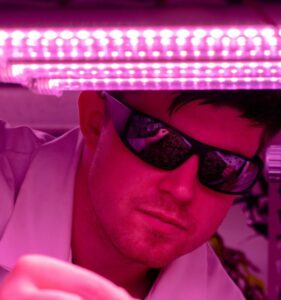
Quartz lamps and above all mercury vapor lamps were used as a precursor to today’s UV-LED lamps in the 20th century, but these have now been almost completely replaced by today’s UV-LED technology and corresponding UV-LED flashlights or UV hand lamps for inspection.
Due to the electronic monitoring of the TC1 flashlight and the many other advantages of this NDT flashlight, handling has become much easier and more comfortable, and the visual inspection has become much more precise and reliable. Especially in the field of NDT, i.e. magnetic particle testing and fluorescent dye penetrant testing, the use of UV LED flashlights and UV LED modules has generally become firmly established.
Care, cleaning and maintenance of a UV flashlight for NDT. That is how it goes:
- Clean the UV lamp housing with a cloth
- Wipe out the battery compartment from time to time
- Clean the lamp housing with washing-up liquid or clean water
- Wipe the UV flashlight cover glass with a damp, soft cloth. Important: there must be no scratches!
What terms are customers and interested parties from NDT also looking for when it comes to UV flashlights?
What is the best way to research UV LED Flashlights on the World Wide Web? Below are common terms for the UV LED flashlights for NDT which are the most commonly used: black light lamp, UV LED flashlight, ultraviolet flashlight, NDT flashlight, FPI flashlight, MPI flashlight UV LED flashlight for NDT/FPI/MPI, etc. Also “Manufacturer of UV-LED flashlights” or “High-power UV-LED flashlights” are appropriate terms. Of course, the TC1 UV flashlights are also used for leak detection.
To schedule a product demo or request further product information, please fill in your contact details.
We look forward to your inquiry!
You are also welcome to contact us by phone or email.
Direct contact:
SECU-CHEK GmbH
An der Fähre 9
66271 Kleinblittersdorf
GERMANY
Phone +49 6805-942859-0
Fax +49 6805-942859-95
Email: info@secu-chek.de

